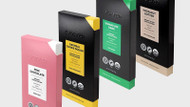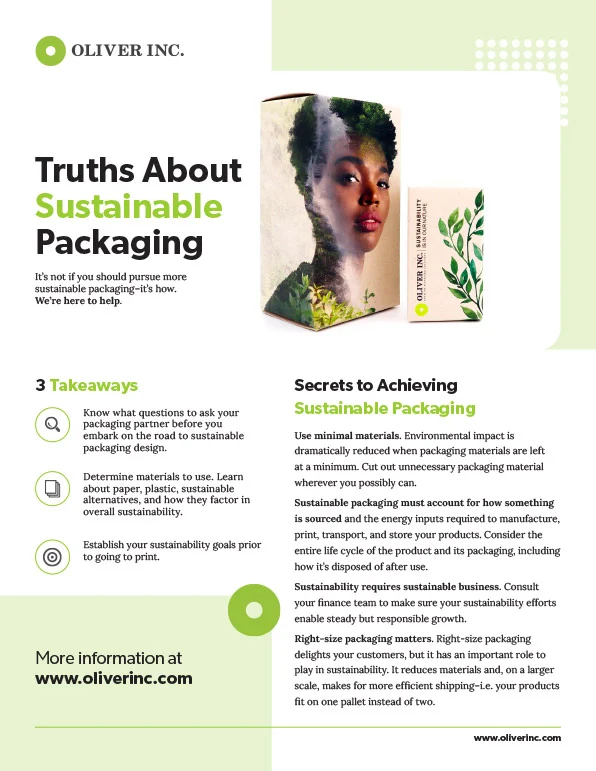Design Tips for Custom Retail Packaging
Posted by Oliver Inc. on 23rd May 2024
An overview:
- Custom retail packaging goes beyond visuals and materials; it aims to create a memorable unboxing experience that tells your brand’s story.
- E-commerce and retail packaging have different priorities, however. While e-commerce focuses on durability for shipping, retail prioritizes visual design to attract aisle shoppers.
- Design tips for custom retail packaging include structural innovation, vibrant color selection, tactile decorative effects, and incorporating brand narratives.
- Sustainability is increasingly important in packaging design, with consumers valuing brands that align with their environmental values.
Custom retail packaging design is about more than choosing the right visual elements or even selecting the most effective materials for your folding cartons. You want to create a memorable unboxing experience that also tells a compelling story about your brand and what you value.
E-Commerce & Custom Retail Packaging Have Different Priorities
Some brands try to double-dip, using the same packaging design for standard retail products and e-commerce distribution. Many do this out of necessity, usually due to limited budgets.
However, e-commerce and custom retail packaging are informed by different goals.
E-Commerce Packaging Must Be Tough
E-commerce packaging needs to prioritize protection above all else.
These packages undertake epic journeys, are jostled about by conveyor belts, packed into trucks, and potentially travel cross-country before reaching their final destinations—your customers’ doorsteps.
Durable corrugated boxes and reinforced seams are essential for ensuring your products arrive intact and ready to delight.
For e-commerce, your primary packaging—the layer closest to your product—must echo the sturdiness of the secondary layer.
Custom Retail Packaging Is All About Visual Design
Retail packaging, on the other hand, is the dazzling first impression that charms shoppers in the store aisle.
While protection is still important, the design of these packages is the true star. Vibrant colors, eye-catching logos, and creative structural designs all vie for attention in a crowded retail environment. This packaging needs to excite and entice at first glance.
Another key distinction lies in the unboxing experience.
Unboxing videos have become wildly popular, putting the focus on delivering a premium branded experience from the moment your package arrives. Custom inserts, branded tape and labels, connected packaging principles, and printed marketing collateral elevate an otherwise standard shipment into a noteworthy brand interaction.
In contrast with the brawniness of e-commerce packaging, retail products are designed to be rapidly disrobed on the sales floor or in an excited flurry at home. Convenience for the customer reigns supreme here with easy-open perforations, resealable closures, and packaging that seamlessly transitions into simple storage.
So, how do you design custom retail packaging with unrivaled allure?
Custom Retail Packaging Design Tips
Unleash Structural Ingenuity
In the perpetual battle for customer attention, packaging structure is your secret weapon. Getting it right adds abundant value to your products.
Eschew bland boxes for designs that intrigue with uncommon shapes contoured to fit your product, unexpected reveals featuring peek-a-boo windows, and whimsical elements to catch consumers off guard. Curvaceous contours, asymmetric forms, and innovative mechanics transform your packaging from mundane to masterpiece.
Their unique shapes will help your products stand out among generic folding cartons on the shelf.
Consider, for example, how plant-based body care products company Indigo Wild implements durable 18pt C1S construction with a matte aqueous finish for its F&M Zum Glow Votive packaging. Its custom windows entice consumers with a preview of what’s inside.
Captivate With Vibrant Colors
Energetic palettes are the siren's call that enchants consumers amidst a sea of competitors. Build desire by playing with contrasting hues, luscious gradients, and lively color-blocking.
Spot UV printing accentuates particular visual elements, such as a logo, giving your folding carton resplendence that pulls eyes to your brand.
If you need near-exact color-matching, employ extended gamut printing. Also known as expanded gamut printing, this advanced technology features the standard run of CMYK (aka four-color process) plus green, orange, and violet.
While extended gamut printing has been around for decades, what is relatively new is the Pantone EG Color Guide, which now gives industries a clear standard to follow. As a result, printing companies have found great success matching colors with the extended gamut.
Wellness brand The Healthy Elephants, for instance, employs robust 20pt C1S material embellished with vibrant CMYK color for its Balance Daily Complex Capsules Box.
Embrace the Tactile Side of Packaging
In retail, packaging is a sculpture—meant to attract consumers through senses beyond mere sight.
Incorporate unexpected textures that beckon touch, such as soft-touch coatings and plush flocking; the packaging wants to be felt.
Embossing and debossing, which entail raising or lowering visual elements into the substrate, turn your folding carton into a 3-dimensional canvas.
Top-tier materials such as iridescent foils bestow an aura of exclusivity and covetable quality. Hot foil stamping uses, well, heat to attach metallic material to substrates, while cold foil stamping achieves this utilizing ultraviolet light. No longer constrained to silver and gold, foil stamping can be done in nearly any color.
For instance, organic chocolate brand Evolved Chocolate has rolled out a sleek modern design that makes smart use of embossing, inviting consumers to grab its chocolate right off the retail aisle.
Craft the Quintessential Unboxing Experience
The unboxing ritual now reigns supreme in today's consumer experience—with such videos all over TikTok, Instagram, and YouTube.
Engineer layers of anticipation by incorporating unveiling mechanisms and nested package elements. Surprising reveals, branded inserts, and sensorial cues such as embossed textures or aromatic coatings transform the opening of your product into an indelible event.
By delivering a memorable unboxing experience, you create a moment consumers will forever associate with your brand, who you are, and what you value. Be sure to craft it carefully.
After all, sometimes you only get one shot.
Consistency across products and connected packaging elements such as QR codes, which bridge consumers to digital platforms, are ubiquitous parts of a strong unboxing experience.
Beauty brand LilyAna Naturals implements these practices beautifully.
Lure With the Power of Story
Great packaging transcends mere containment through enchanting narratives and is, perhaps, your primary means of disseminating your brand’s narrative.
A growing number of consumers are becoming more value-conscious with their purchasing habits, shopping for brands whose missions and values align with their deeper moral commitments.
This can come in the form of taking stances on social issues, encouraging consumers to recycle your packaging, or highlighting the work your brand is doing to support the communities in which you operate.
Sustainability, in particular, is increasingly a cause brands cannot afford to overlook.
Demonstrate your brand's environmental ethos with renewable materials including hemp- and cotton-based alternatives and post-consumer recycled paperboard. Paperboard is usually the more environmentally friendly alternative to plastic containers, but it must derive from responsibly managed forests as certified by the nonprofits Forest Stewardship Council (FSC) and Sustainable Forestry Initiative (SFI).
You can also reinforce your green credentials by implementing right-sized packaging principles into your overall design. That means using only as much packaging material as needed to protect or secure your product during transportation, storage, and discard. Remove unnecessary air pockets and cut out excessive filler materials.
Environmentally minded consumers notice how much material your brand uses in packaging, especially when it's single-use plastic. And they tend to punish those who disregard sustainability practices.
A purveyor of “planet-friendly cleaning products,” Meliora relies on neutral substrate colors and plastic-free materials to reinforce its commitment to sustainability.
Partner With Oliver for Sustainable Packaging Design
The right combination of colors, decorative effects, and materials will help your custom retail packaging pop off the shelf.
But if you don’t find continual ways to integrate sustainability into your packaging design, consumers will return your products to the shelf the moment they realize your brand isn’t making sufficient steps toward reducing your carbon footprint or counteracting climate change.
Oliver can help you with that.
Equipped with the most up-to-date printing technology and a deep commitment to sustainability, Oliver has helped brands across many industries transition to more environmentally friendly custom retail packaging.
From consumer goods and pharmaceuticals to food and beverage and health and beauty, Oliver works closely with brands throughout the design process, and beyond.
Our human-centered approach means your pain points are our problem to solve.






